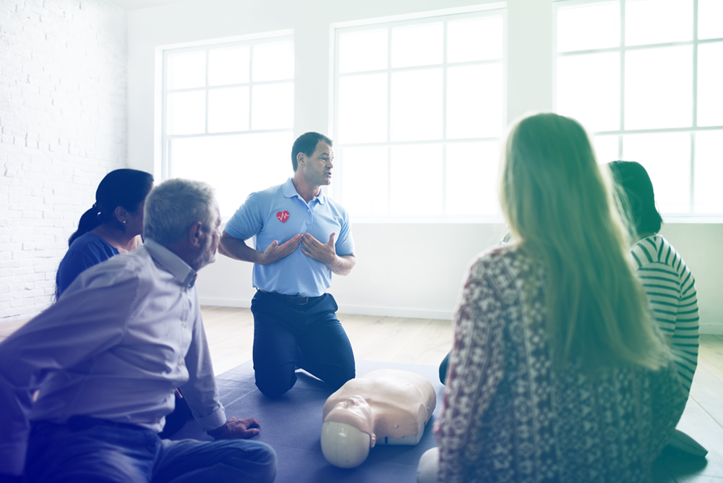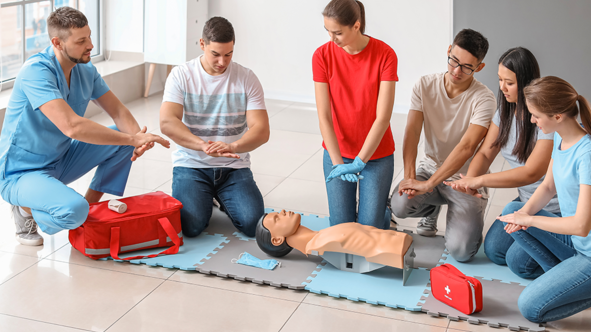Why?
Workplace accidents and work-related illnesses should be prevented as much as possible. But accidents can happen at any time. And when they do, it is important that a trained first aider, with the appropriate equipment, is able to administer first aid.
Every employer of 20 employees or more is obliged to have trained first aiders available. Mensura is authorised to organise this training and will provide you with a certificate that is valid in Belgium.
Certificate valid in Europe
This course provides you with a European certificate in 'Life-saving techniques'. Our experts are recognised by the European Resuscitation Council (ERC).
What do you learn?
You will learn the theory and practice of first aid. The tasks of a first aider are covered and you learn how to correctly evaluate an emergency situation. You will learn about such matters as how to administer first aid, recognise vital signs and syndromes, perform resuscitation, treat common injuries, and bandaging methods. You will be taught in small groups of no more than 8 people to optimise learning.
How is the programme structured?
Introduction
The role of the first aider
Legislation and practical implications
Recording of incidents and actions
Demonstration of first aid equipment
General approach to emergency situations
Safety and hygiene
Monitoring of vital functions:
- Consciousness
- Respiration
- Circulation
Alerting: notifying emergency services
Approach to victim(s) and further first aid
Practical exercise: step-by-step plan
Moving a victim in distress
Technical
Practical exercise: Rautek manoeuvre
The vital functions and clinical symptoms
Loss of consciousness
- Fainting
- Concussion
- Stroke
- Epilepsy
- Diabetes
- Carbon monoxide poisoning
Respiration
- Shortness of breath
- Hyperventilation
- Asthma
- Asphyxiation
Circulation
- Angina
- Heart attack
Practical exercises
- Recovery position
- Using an isothermal blanket
Demonstrations
- Hyperventilation
- Suffocation – blows to the back – abdominal thrust
- Heart attack
Basic resuscitation and AED
Basic resuscitation "30-2"
Use of an AED
Practical exercises
- Resuscitation '30:2'
- Using an Automatic External Defibrillator (AED)
Types of bleeding and shock
Basic resuscitation "30-2"
Use of an AED
Practical exercises
- Resuscitation '30:2'
- Using an Automatic External Defibrillator (AED)
Types of bleeding and shock
External bleeding
Internal and external bleeding
Shock
Practical exercise: compression bandage
Demonstration: nosebleed
Injuries to the locomotor system
Stiff muscles
Muscle cramp
Muscle strain
Bruising
Sprain
Dislocation
Fractures
Spinal injuries
Practical exercises
- Wrist bandage
- Triangular bandage as a sling
Skin wounds
Abrasions
Cuts
Puncture wounds
Splinters
Blisters
Blue nail
Bites
Insect bites
Tick bites
Practical exercises
- Disinfecting a wound
- Bandage on finger
Burns, electrocution and electrification
Skin burns
Chemical burns
Burning of the respiratory tract
Frostbite
Electrocution and electrification
Practical exercise: triangular bandage as a temporary cover
Injuries and incidents
Head injuries
Eye injuries
Hypothermia
Overheating
Drowning
Poisoning
Demonstration: Flushing of eyes
Links
Practical exercise: links
First aid certificate
After the course, you will receive the official first aid certificate recognised by the Federal Public Service Employment, Labour, and Social Dialogue (FPS WASO) and the European 'Life-saving techniques' refresher certificate recognised by the European Resuscitation Council (ERC).
This course is part of our Impact-offer

Those wishing to go deeper into a specific topic will find what they are looking for in our Impact training. We ensure a lasting impact using a mix of experience-based, social, and digital learning.
Result?
This basic course on first aid teaches you the theory and practice of first aid. As a certified first aider, you know how to administer first aid to victims of workplace accidents. Specifically, as a first aider, you can:
- Provide first aid.
- Support, protect and move a victim.
- Get yourself to safety.
- Resuscitate and use the Automatic Electrical Defibrillator (AED).
- Provide Basic Life Support (BLS) including checking the victim, chest compressions, breathing, putting the victim into the recovery position.
- Assist with unconsciousness.
- Recognise and treat burns and skin wounds
- Treat (nose) bleeding.
- Intervene in case of choking and hyperventilation.
- Intervene in case of poisoning.
- Recognise and treat neck, spine, brain and eye injuries, and injuries to bones, muscles and joints.
- Provide assistance in case of stroke and heart attack.
- Know and apply different bandaging techniques.
We work with continuous evaluation during the training. After the course, you will receive the official first aid certificate recognised by the Federal Public Service Employment, Labour, and Social Dialogue (FPS WASO) and the European 'Life-saving techniques' certificate recognised by the European Resuscitation Council (ERC).
Mandatory refresher training first aid
The Social Welfare Act requires an annual refresher course for certified first aiders.
If you take the course 'Emergency response officer (first aid) - basic level with European certificate', you are obliged to :
- Attend the annual 'Refresher training emergency response officer (first aid)'. This allows you to refresh your knowledge and skills, keep up-to-date with new techniques and maintain your certificate.
- Every three years, follow the 'Refresher training emergency response officer (first aid) - European certificate' to maintain your European certificate for first aiders.
For example, if you take the ‘Emergency response officer (first aid) – basic level with European certificate’ in 2025, you will then take the 'Refresher emergency response officer (first aid)' every successive year ànd the 'Refresher training emergency response officer (first aid) – European certificate' course in 2028, etc…
Tip: both refresher trainings last half a day, so make sure to ask for a customised quote if you want to combine the two refresher trainings in one day.
For whom?
This course is for anyone who want to learn the basics of first aid at work and obtain a European certificate. Recommended for international organisations.
What does the law say?
Legally, as an employer of 20 employees or more, you must have trained first aiders to provide first aid in case of accidents at work or health problems in the workplace.
The number of first aiders depends on company size, on the one hand, and the risks faced by employees, on the other. Based on these criteria, companies are divided into 4 categories: A, B, C and D. More info? Take a look at the site of the FPS WASO.
Care providers must have a certificate from a recognised training centre. Mensura is listed by the Federal Public Service on Employment, Labour and Social Dialogue (FPS WASO) as a training institution that may provide this basic course on first aid.
The European 'life-saving techniques' certificate may also be useful for international companies. You will also receive this certificate after completing this training thanks to our experts recognised by the European Resuscitation Council.
Price
The price depends on how you follow the training.
If your organisation is affiliated with Mensura External Service for Prevention and Protection at Work (ESPPW) and you have prevention units, you can pay with these as long as your balance is sufficient.
A digital course with e-learning on the ERC platform is included in the price.
Options:
- Training courses can be held in the evening or at the weekend for an additional fee.
Interest in options can be indicated in the quotation form.
Subsidies and financing options
We qualify for all kinds of subsidies and financing options because we are certified by many government agencies and sector funds.
- SME-Portfolio. Use these certification numbers in your request:
- members of Mensura External Department for Prevention for Prevention and Protection: Mensura EDPB - DV.O105072
- non-members: Mensura CONSULT - DV.O101943
- Training vouchers
- Sector fund
- Alimento
- Constructiv
- Sectoral Training Fund Service Cheques
Frequently Asked Questions
What is the difference between an initiation, a refresher course, and a basic course?
An initiation is an awareness training for all staff in your company. This ensures everyone reacts appropriately in the event of an accident. You do not receive an official certificate.
After a basic course, you receive a certificate and are then a first aider in your company. You retain that certificate on completion of the mandatory annual refresher course.
How many first aiders are needed in my organisation?
This is determined by the risk analysis. You can find a recommendation per sector here.
Is something unclear? Then contact your external Mensura prevention adviser.





